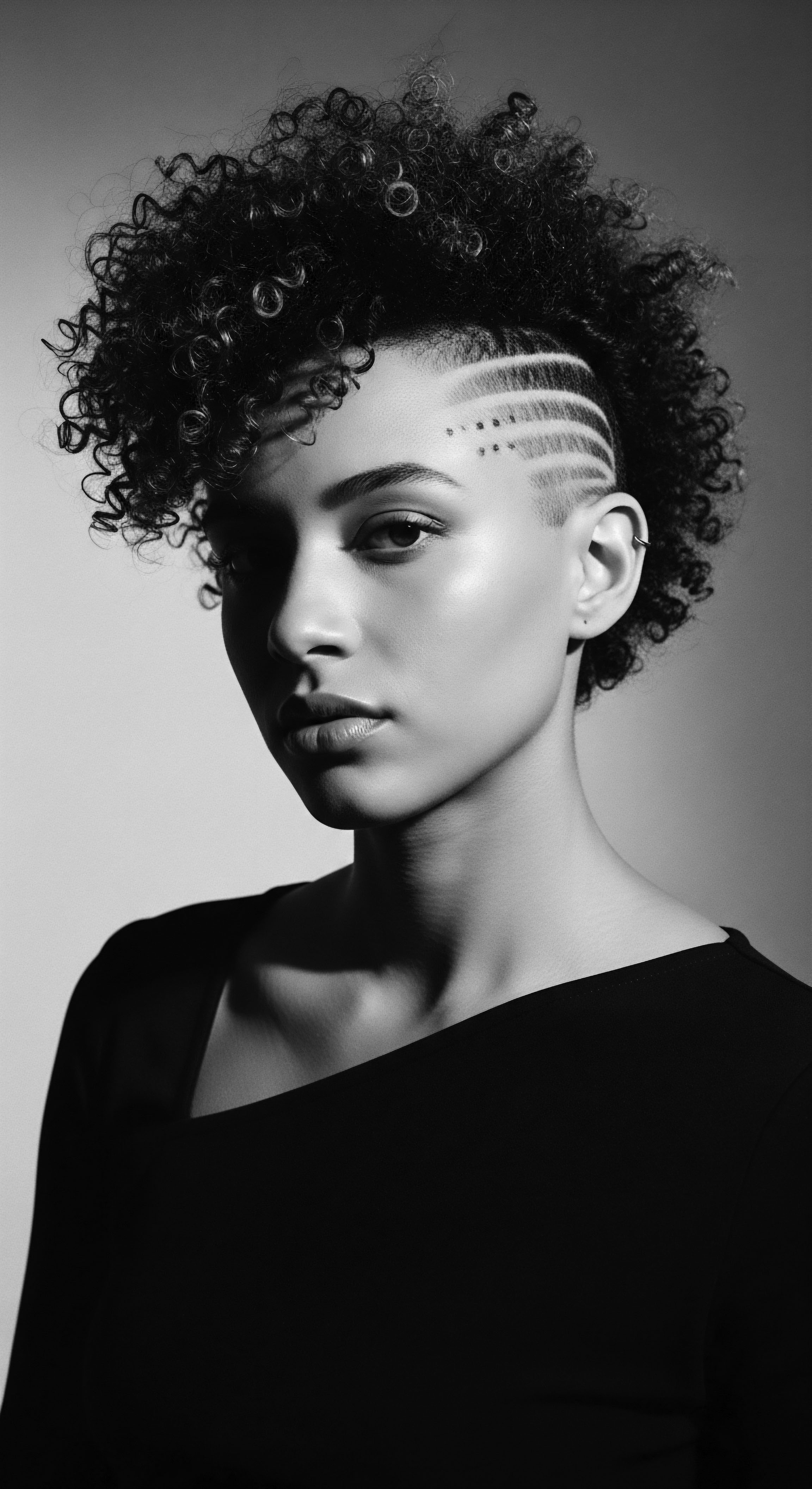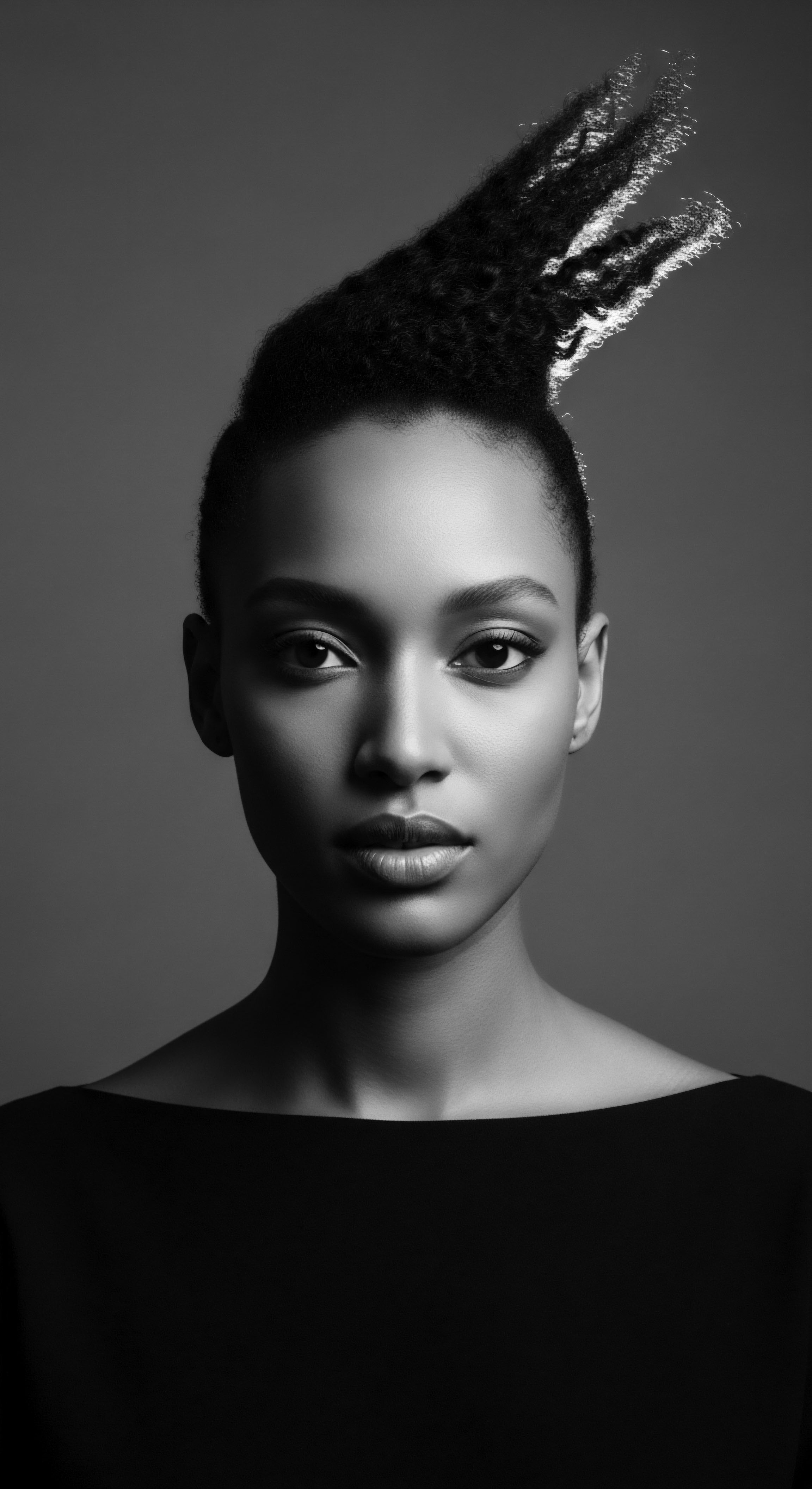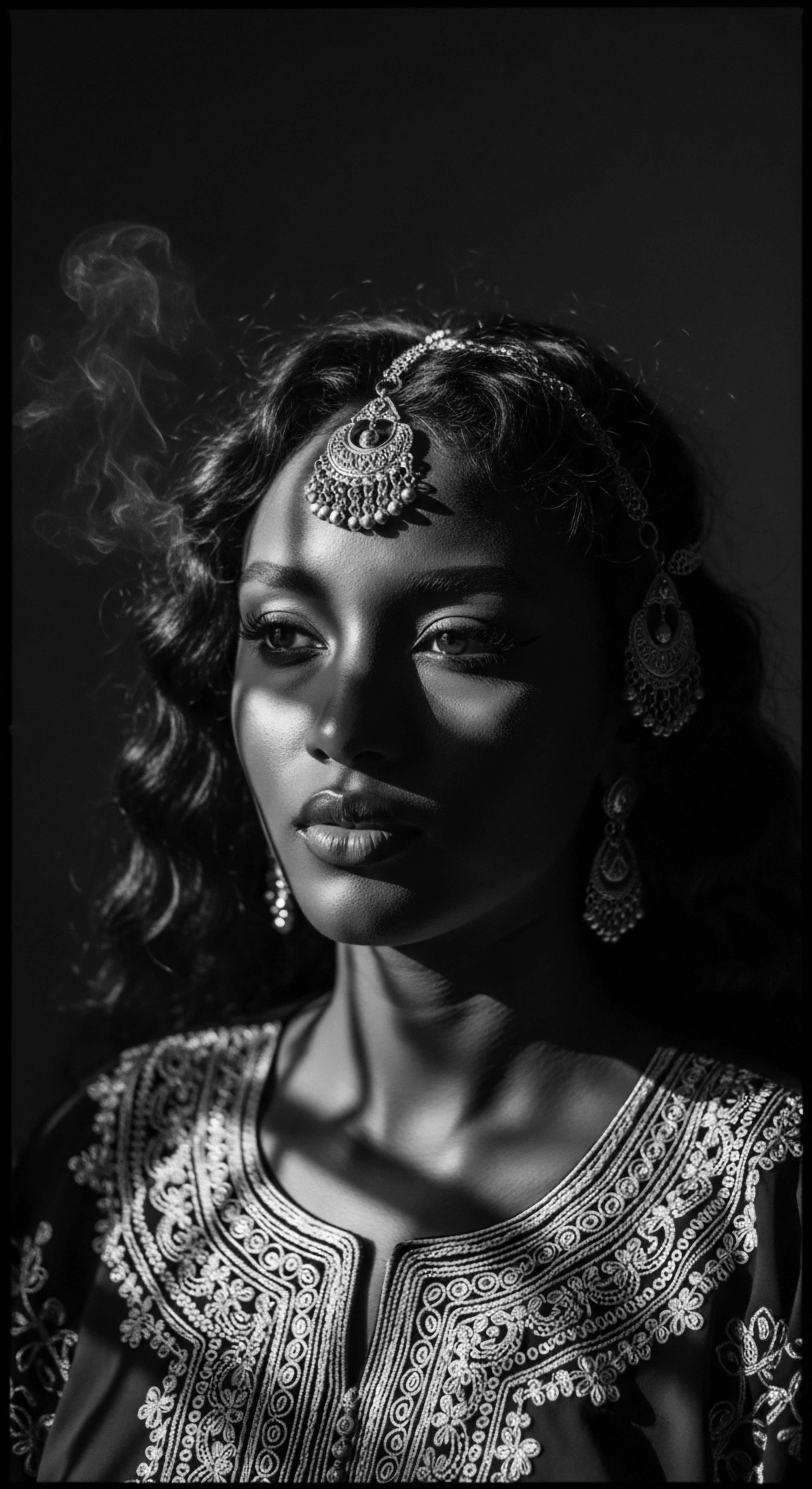
Roots
There exists a profound connection between who we are, where we come from, and the very strands that crown our being. For textured hair, this connection runs particularly deep, etched into every coil, every curve. It is a story not just of biology, but of generations—a living archive of resilience, wisdom, and an unwavering commitment to care, even in the harshest winds of history. When we speak of hair moisture, we are not simply discussing a superficial treatment; we are whispering secrets passed down through millennia, acknowledging the very ancestral blueprint of this magnificent hair type and its inherent requirements.

Anatomy and the Ancestral Whisper
The science of textured hair, when observed through the lens of heritage, unveils a fascinating narrative. Unlike its straighter counterparts, the follicle of textured hair is typically elliptical or flat in shape, leading to a hair shaft that grows in a unique, often tight, helical pattern. This distinct architecture means that the cuticle layers, which serve as the hair’s protective outer shield, do not lie as flat or overlap as smoothly. Instead, they are often lifted at the curves, creating tiny gaps through which vital moisture can easily escape.
This structural predisposition means textured hair, from its very origin, exists in a state of yearning for hydration. It is, in its elemental form, inherently prone to dryness. This biological truth was not lost on our forebears; their practices, intuitively developed across continents, spoke directly to this fundamental need, even if the precise scientific language was yet to be articulated. The very climate of many ancestral lands, often arid or intensely sunny, further amplified this natural inclination towards dryness, prompting solutions that mirrored the earth’s own abundance.
The intrinsic helical shape of textured hair, a hallmark of its heritage, creates natural points of vulnerability where moisture readily escapes.

Understanding the Hair’s Deep Past
Within indigenous African societies, hair was an identifier, a spiritual conduit, a marker of status, and a communicator of marital state or age. The care afforded to it was therefore far from casual; it was a sacred practice, often communal, often infused with botanicals known for their restorative properties. The very lexicon that emerged around textured hair did not separate its health from its appearance. Words conveyed a holistic view, where a strand’s luster signaled not only beauty but also vitality.
This understanding, that a healthy hair reflects a healthy self, formed the cornerstone of ancestral care. The emphasis was always on supporting the hair’s natural inclinations, including its need for rich, sustaining fluids and emollients. This historical commitment to hydration became an unwritten law, woven into the fabric of daily life long before modern laboratories began to dissect the protein bonds and lipid layers.

Hair Growth Cycles and Earthly Gifts
The cycles of hair growth, too, hold lessons from the past. While science now categorizes phases like anagen, catagen, and telogen, ancient communities understood hair as a perpetually renewing fiber, deeply connected to bodily health and the natural world. Factors influencing growth and retention—nutrition, environment, and physical manipulation—were observed and addressed through diet and careful handling. The dry climates prevalent in many African regions meant that even ambient air sought to draw moisture from the hair.
This environmental constant necessitated the regular application of plant-derived butters and oils, not as luxuries, but as a shielding necessity. The ingenuity of these ancestral practices lay in their direct response to the hair’s inherent needs and the challenges presented by their surroundings, preserving length and strength through a constant vigil against dehydration.
| Aspect Hair Structure & Water |
| Ancestral Understanding Recognized hair's tendency to dry; used external applications. |
| Contemporary Science Identifies raised cuticles, elliptical shape leading to moisture loss. |
| Aspect Key Moisturizers |
| Ancestral Understanding Reliance on plant butters, animal fats, and oils. |
| Contemporary Science Validates efficacy of lipids (fatty acids) and humectants (water-attracting substances). |
| Aspect Protective Measures |
| Ancestral Understanding Braiding, threading, head coverings. |
| Contemporary Science Confirms benefits of reducing manipulation and environmental exposure. |
| Aspect The enduring wisdom of ancestral practices often aligns with current scientific understanding regarding textured hair's vital need for moisture. |

Ritual
The story of textured hair care is one deeply entwined with ritual, transforming daily tending into acts of cultural continuity and self-affirmation. The need for moisture became the silent orchestrator of countless traditions, shaping techniques, dictating tool design, and inspiring the very transformations that allowed hair to speak volumes without uttering a single sound. From the sun-baked plains where shea trees generously offer their golden balm, to the bustling markets where ancestral knowledge of botanicals found new expressions, the preservation of moisture has been a sacred thread running through the very fabric of textured hair heritage.

Protective Styling Lineage
The heritage of protective styles stands as a testament to deep knowledge regarding moisture preservation. Cornrows, twists, braids, and Bantu knots were not merely adornments in various African civilizations; they served as ingenious methods to shield the delicate strands from environmental aggression and minimize manipulation. These styles kept the hair tucked away, reducing surface area exposed to drying air and preventing the physical friction that could lead to breakage and further moisture depletion.
The act of creating these styles was often communal, a space for shared stories, wisdom, and the application of nourishing preparations designed to lock in hydration. This communal aspect fortified not just the hair, but the bonds of kinship and cultural memory.
Protective styles, born from generations of wisdom, became silent guardians of moisture and cultural connection.

Natural Styling and Ancestral Definition
Even when hair flowed freely, or was styled to accentuate its natural curl, methods were developed to sustain its internal water balance. Techniques for defining coils without stripping them of moisture were honed over centuries, often involving the strategic layering of water and oils. This approach, echoed in modern liquid, oil, cream (LOC) or liquid, cream, oil (LCO) methods, demonstrates a timeless understanding of how to encourage the hair’s intrinsic pattern while simultaneously ensuring its hydration. The smooth application of rich butters and emollient oils, worked gently through sections, speaks to an inherited patience and precision, ensuring every segment of hair receives the nourishment it craves.

Hair’s Tools and Cultural Legacy
The tools employed in textured hair care—from wide-toothed combs carved from wood or bone, to rudimentary detangling implements crafted from whatever material was at hand—were designed with consideration for the hair’s fragile, dry nature. These implements were not about aggressive force, but about gentle navigation, minimizing strain on hair that could easily snap if mishandled when dry. The very act of combing or parting was often accompanied by the application of oils or water, a practical ritual to ease passage and reduce friction. The tools, humble as some might appear, were extensions of a collective understanding that textured hair, thirsty by nature, demanded a delicate touch and constant replenishment of its inner reserves.
The enduring need for moisture has meant that certain tools have remained central to textured hair care across generations. Consider the significance of the hair pick, for example. While its form has evolved, its purpose, to lift and volumize without disturbing the curl pattern excessively, thereby preserving the trapped moisture within the coiled strands, remains fundamentally tied to traditional practices of separating and managing dense hair with care. This legacy stretches far beyond mere aesthetics, pointing to practical solutions for managing hair that is structurally predisposed to tangles and dryness, where robust tools are necessary to navigate its intricate landscape without causing harm.
- Shea Butter ❉ Known in West Africa as “women’s gold,” this butter has been used for centuries to protect hair from harsh environmental conditions and provide deep conditioning.
- Red Palm Oil ❉ Used in Central and West Africa, its deep hue belies its capacity to moisturize and protect hair from sun exposure.
- Baobab Oil ❉ Extracted from the “Tree of Life,” this oil from Southern and Central Africa offers intense moisture and repair.
- Ghee ❉ In some East African communities, clarified butter was used as a traditional hair treatment for moisture and pliability.
| Tool Wide-Tooth Comb |
| Traditional Application Gentle detangling of damp hair or hair coated with oils. |
| Moisture Connection Reduces breakage on dry, fragile strands, preserving length. |
| Tool Fingers (Hand) |
| Traditional Application Initial detangling, applying products section by section. |
| Moisture Connection Allows for sensitive handling, even distribution of emollients. |
| Tool Head Scarves/Wraps |
| Traditional Application Protection from sun, wind, and dust during the day; overnight cover. |
| Moisture Connection Minimizes external moisture loss and physical damage. |
| Tool Clay Jars (for butters/oils) |
| Traditional Application Storing precious, handmade moisturizers. |
| Moisture Connection Ensures preservation and accessibility of hydrating agents. |
| Tool Each tool, from the simple comb to the protective wrap, played a role in the age-old pursuit of sustained moisture for textured hair. |

Relay
The story of textured hair, its care, and its need for moisture is not a stagnant tale from a distant past; it is a dynamic relay, a continuous handing off of wisdom, sometimes unbroken, sometimes rediscovered. The biological predispositions of textured hair, coupled with the historical experience of communities often navigating challenging environments and even deliberate attempts at cultural erasure, solidify the enduring significance of moisture. It is a fundamental truth passed down through generations, shaping not only individual regimens but also the very contours of collective identity. The intricate dance between the hair’s structure and its inherent thirst echoes through time, compelling us to look closely at why moisture holds such an esteemed position.

Building Regimens from Ancestral Wisdom
The development of hair regimens for textured hair, both in antiquity and contemporarily, has always circled back to the paramount requirement for moisture. Our ancestors, living in diverse African biomes, observed and adapted. They learned which plants, which oils, which butters could offer respite to dry strands and scalps, often intuiting the very properties that modern science now categorizes as humectants or emollients.
This knowledge, honed through generations of trial and observation, forms the very bedrock of what we now consider effective textured hair care. These foundational practices, focused on consistent replenishment and protective shielding, are not merely historical footnotes; they are guiding principles for building personalized routines today.

The Nighttime Sanctuary and Bonnet Wisdom
The ritual of protecting hair at night, often with scarves, bonnets, or intricate wraps, is a practice deeply rooted in the heritage of textured hair care. This was not simply about preserving a style for the morning. It was, at its heart, about safeguarding the hair’s precious moisture content from the friction of sleep and the dehydrating effects of absorbent materials like cotton.
Throughout the African diaspora, the headwrap and later the bonnet became a symbol of care, a shield against external elements, and a private sanctuary for hair to rest and retain its hydration. The quiet act of tying on a scarf or donning a bonnet before sleep is a direct continuation of ancestral wisdom, a testament to understanding the critical vulnerability of textured hair to moisture loss during prolonged contact with abrasive surfaces.
The nightly ritual of hair protection, a legacy passed through generations, safeguards textured hair’s vital moisture from environmental stressors.

What Defines Textured Hair’s Moisture Needs?
Why exactly does textured hair crave moisture with such insistent demand? The answer lies within its very physical make-up. Textured hair strands are characterized by an elliptical cross-section, a shape that causes the hair to curl and coil tightly. This coiling pattern means that natural oils produced by the scalp, known as sebum, struggle to travel down the entire length of the hair shaft.
Gravity and the very twists and turns of the helix impede its smooth descent, leaving the ends of the hair, often the oldest and most fragile parts, particularly vulnerable to dryness. Furthermore, the cuticle layers—the hair’s outermost protective scales—do not lie as flat against the shaft in textured hair as they do in straight hair. These lifted cuticles create more points of exposure, allowing moisture to escape more readily from the hair’s inner cortex. This combination of limited natural lubrication and a more permeable outer layer makes textured hair inherently predisposed to dryness and, consequently, breakage.
Consider the historical context of this biological reality. In many African regions where textured hair evolved, the climate is often dry or dusty. This environmental factor further exacerbates the hair’s natural tendency towards moisture loss. Ancestral communities, without the benefit of microscopic analysis, intuitively understood this need.
Their hair care practices—the frequent application of rich plant butters like shea and cocoa, the use of various oils, and the adoption of protective styling—were direct, empirical responses to these inherent challenges. They were, in effect, performing a constant act of hydration to counteract the hair’s structural vulnerabilities and environmental pressures, ensuring its strength and vitality. The resilience of textured hair, therefore, has always been inextricably linked to the intentional provision of external moisture.

Holistic Influences on Hair Health from the Source
Beyond topical application, ancestral wisdom consistently connected hair health, and thus its moisture, to overall well-being. This holistic perspective views the body as an interconnected system, where diet, hydration, and even spiritual harmony reflect in the hair’s vitality. The use of nourishing foods, clean water, and stress-reducing communal practices were all indirectly, yet effectively, contributing to the body’s internal moisture balance, which in turn supported healthy hair.
The wisdom was intuitive, grounded in centuries of observation ❉ a nourished body produces vibrant hair. This deep-seated understanding of interconnectedness between internal health and external radiance continues to inform modern holistic hair wellness approaches, reminding us that true moisture begins from within.
A poignant historical example underscoring why moisture has been so crucial for textured hair, particularly within the Black experience, lies in the brutal realities of the transatlantic slave trade. Upon forced arrival in the Americas, enslaved Africans were systematically stripped of their traditional tools, their natural hair products, and often, their very hair through forced shaving. This was a deliberate act of dehumanization and cultural erasure. Yet, despite these harrowing circumstances, enslaved women ingeniously found ways to continue caring for their hair, often using whatever meager resources were available ❉ discarded animal fats, cooking oils, and even simple cloths for wrapping.
These resourceful acts were not merely about hygiene; they were profound acts of defiance and cultural preservation, ensuring that moisture was maintained to prevent catastrophic breakage and scalp ailments in harsh conditions. As Dr. Gwendolyn P. Cross (2007) highlights in her work examining African American beauty culture, the very act of maintaining hair health, often through rudimentary means of hydration, became a quiet yet powerful form of resistance, preserving a tangible link to identity and ancestral heritage amidst unspeakable trauma.

Reflection
The journey through the intricate world of textured hair and its enduring reliance on moisture reveals more than mere scientific principles; it unveils a profound narrative of heritage. Each coil and curl holds within it the wisdom of ages, a testament to resilience, adaptation, and an unwavering spirit of self-preservation. From the earliest ancestral practices, where plant-derived butters and oils were instinctively applied to combat inherent dryness and environmental rigors, to the ingenious methods developed in the face of forced displacement and cultural erasure, the consistent provision of moisture has been an act of profound care and continuity.
It speaks to a living legacy, where the health of a strand reflects not just individual well-being, but the collective strength of a people. The Soul of a Strand, then, is not simply its physical composition, but the interwoven stories of those who have tended to it, honored it, and understood its undeniable thirst across generations, recognizing that proper moisture is the very lifeblood of its magnificent heritage.

References
- Cross, Gwendolyn P. Living Beautifully ❉ African American Women and the Struggle for Beauty and Identity. New York University Press, 2007.
- Dye, Jane. Aromatherapy for Mother and Child. C.W. Daniel Company, 1992.
- Falconi, Dina. Earthly Bodies and Heavenly Hair. Ceres Press, 1998.
- Hampton, Aubrey. Natural Organic Hair and Skin Care. Organica Press, 1997.
- Loussouarn, Geneviève. “Hair Shape, Ethnic Origin and Biology.” Journal of the American Academy of Dermatology, vol. 59, no. 5, 2008, pp. S65-S71.
- Ogbeide, Uyi. Traditional African Hair Care Practices and the Modern Natural Hair Movement. University of California, Berkeley, 2018.
- Okunniwa, Liha. LIHA Beauty Interview with Vogue Magazine. 2023.
- Rajbonshi, Anushree. Processing of Shea Butter from Nuts of Vitellaria paradoxa. LAP Lambert Academic Publishing, 2021.
- Diop, Taïb. Les Plantes Medicinales, Sénégal. 1996.
